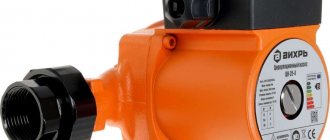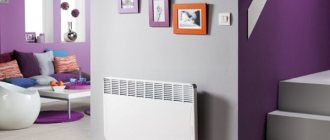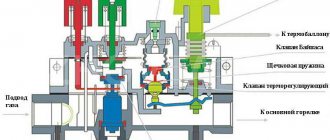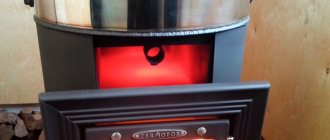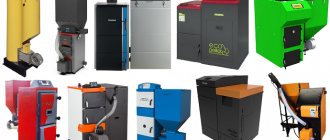Modern soft carpet is one of the most energy efficient types of flooring. It is installed in children's rooms, play areas and other rooms with increased operational requirements to reduce heat loss and increase safety. However, for some property owners, the thermal properties of carpeting are not enough, which is why they prefer installing an additional heated floor in the body of the screed, or directly under the soft finishing material.
Warm floor under carpet
Main advantages and benefits
- Energy saving. The biggest advantage is that the wall panel heater consumes a small amount of electricity. Compared to oil radiators and convectors, savings can be up to 80%.
- Requires 220V voltage. For a film-type wall heater, you will need a regular 220V socket. At the same time, there is no increased load on the network, which is very important for summer cottages, where there are often problems with the electrical network.
- Product durability. Most manufacturers guarantee that such a thin wall heater will last at least 60 thousand hours. If you take into account daily use, this is seven years or more.
- High efficiency rate. It is quite easy to explain why infrared heaters have a higher efficiency rate. They warm up not the air, but the surfaces they are directed at. But the heated surface of the object itself gives off heat to the air space.
- Easy installation. You don’t need to call specialists; you just need to fasten the heater to the wall with a self-tapping screw. Since this is both a heater and a painting, you can complement the interior and make it more original.
- Operation in any conditions. A modern film heater is not afraid of moisture, it is not exposed to dust or dirt, and it does not burn people. All this makes it possible to use it everywhere. Some even use a wall heater for rabbits when breeding them in the house.
- Light weight and compact. The weight of the product usually does not exceed 700–800 grams; if necessary, you can remove the painting and roll it up. Thus, you can use one heater both at home and in your dacha or even in the office.
Are there any disadvantages to such a heater? There are some disadvantages, but they are minor. Firstly, you should be careful not to expose the canvas to strong mechanical stress, otherwise there is a risk of damaging the carbon threads under the polymer film. Secondly, the film heater heats the room in a directional manner, and usually the heat is felt at a distance of no more than 2-3 meters from the painting.
Types of heated mats
Manufacturers try to please all users, so they offer a wide variety of heating mats. All products can be grouped by purpose and method of heating.
What types of heated mats are there depending on the heating technology?
Several technologies are used to produce warm rugs:
1. Electrical cable mats
Structurally, such products are thin wires laid throughout the mat and well insulated. The models heat up quickly, providing a comfortable floor temperature. Thermal mats are very durable and can be rolled up for storage or transportation.
Installation of a warm mat based on an electric cable.
2. Infrared based mats
The most popular version of warm mats. Graphite strips on a polymer film placed inside a special case are used as a heating element. When connected to an outlet, the film begins to emit infrared rays, which heat surrounding objects.
The device of the mat is based on a film that produces infrared radiation.
Each design has features that influence the choice of rug.
Types of warm mats depending on purpose
According to their intended purpose, heating mats can be divided into several types.
To warm your feet
Electric foot mats are small in size, effectively warm the limbs and do not pose a danger to the body. Low temperature prevents burns.
For pets
Animals that are forced to sleep on a cold floor can also catch a cold. Therefore, in order to create comfortable conditions for pets, it is advisable to purchase a heating mat.
For bathroom
After warm water, it is unpleasant to stand on cold tiles. The thermal mat will prevent you from freezing or slipping on the tile surface.
For auto
In this category, devices with infrared radiation are most often used. They consume little energy, are compact and easy to maintain.
For drying shoes
Rugs are used not only for drying shoes, but also for heating them in cold hallways without heating.
For seedlings
Growing seedlings will be much more successful if you use a special heating mat. Soft heating will prevent the death of plants from temperature changes on the windowsill.
Almost all models are interchangeable; many heat not only locally, but also increase the temperature in the room as a whole.
How to choose a heated mat
Today there are rugs of any size and purpose on sale. In a small room, for example, a child's room, you can cover almost the entire flooring.
Manufacturers offer standard mats that are simply designed for heating, or products with special options. When choosing rugs, you should focus on several parameters:
- appointment;
- type of heating elements;
- surface material;
- energy consumption indicator;
- presence of a thermostat;
- degree of protection against electric shock.
The rug should have a pleasant finish so that it is comfortable to walk on barefoot. Equally important is high-quality protection from moisture.
Purpose
First of all, you need to determine for what purpose you are purchasing a heated mat. The dimensions of the mat depend on its purpose:
- Automotive. They are used for seats or for the floor, while the floor must fit in the legs and not extend beyond the space allocated in the car. Products for cars are adapted for low voltage networks.
- For animals. Pets can scratch or chew the rug, so you need to choose products with increased durability. The animal should first be weaned from damaging the wires. The maximum heating temperature should not exceed 35°C.
- For bathroom. When purchasing a thermal bath mat, you must make sure that it has effective water-repellent properties. It is also important to pay attention to the insulation and anti-slip coating on the back. Antifungal impregnation is applied to many models.
- For legs. Usually, small rugs are produced for this purpose, occupying little space. The maximum temperature is 35-40°C; exceeding this norm can cause burns. There are products whose highest temperature can reach 50°C. If such a carpet is not equipped with a thermostat, then it is better not to buy it.
The largest models are used to heat floors over large areas. In this case, you need to focus on the size of the room where you plan to lay the thermal mat.
Type of heating elements
Each type of mat heating elements has its own advantages and disadvantages:
1. The most durable mats are those using a thin electrical cable. The advantages of the models include heating speed, durability, and the ability to adjust power. But in places where the cable passes, the carpet sags over time, since the heating is uneven. Furniture cannot be placed on the product; internal elements may be damaged.
2. Infrared mats consume a minimal amount of energy, heating the entire surface evenly. Rugs are not afraid of moisture, they are not subject to overheating. However, some products are not recommended to be folded and unfolded multiple times.
Surface material
Many people choose a thermal mat based on its visual appeal. Manufacturers are trying to diversify the colors and coating materials. But in certain places - a bathroom, a car - color is not as important as performance characteristics. For wet and dirty surfaces, it is better to purchase products with a rubberized back side. It is easier to clean and does not slip.
Warm mat with a rubberized side.
Energy consumption indicator
Powerful products heat better, but also consume more electricity. A significant part of modern thermal carpets are designed using modern technologies that require minimal energy consumption. The most economical are infrared type mats.
The presence of a thermostat
The built-in thermostat greatly simplifies the use of the device. Depending on the purpose at the moment, you can set the appropriate temperature. Maximum heating will help create a comfortable atmosphere throughout the room, and you can use medium temperature for your feet. The best choice would be a model with auto shut-off.
Warm mat with thermostat.
Degree of protection against electric shock
Safety is one of the main factors when using electrical appliances. The higher the electrical safety class of a thermal mat, the less danger the product poses during operation. Usually mats have protection class I–II.
Warm floor for carpet
Given the low thermal conductivity of carpeting, not every type of heated floor is suitable for heating a space. Classic equipment, in the form of a heating cable or pipes with liquid coolant, is not recommended for the following reasons:
- Local heating is provided by heat transfer from the surface of the cable or pipe.
- Most of the energy is spent on overcoming the thermal barrier in the form of carpet, which eliminates the uniformity and speed of heating.
- Immediately after turning off the heated floor, the temperature of the carpet returns to its previous values.
Thus, only one category of heated floor is suitable for carpeting - an infrared emitter, which has many of the following advantages:
- The thickness of the mat is no more than 0.4 - 0.5 mm, it is made in the form of a film.
- During operation, a minimum amount of electricity is consumed.
- It can be installed both in the body of the screed and directly under the carpet (the second option is more preferable).
- Heating occurs almost instantly.
- Thermal energy is transferred directly to objects located on top of the carpet, so that the space being used reaches the desired temperature in a few seconds.
Infrared emitter
When choosing an infrared emitter, it is necessary to measure the dimensions of the room in advance, and also exclude from the heating area the places that will be occupied by pieces of furniture.
Another advantage of infrared heated floors is its optimal heating temperature - regardless of the power of the product and the volume of space, the temperature of the heated surface will not exceed 40 - 45 oC.
Which carpet should you choose for heated floors?
When the design of an effective heated floor has been selected and purchased, the owner of the property should order the carpet itself. Experts recommend paying special attention to the following types of carpets:
- For heated floors, baseless thin products that transmit heat well are suitable.
- If you purchase material with a base, you should choose felt or jute products.
- Professionals advise against purchasing carpets with a rubber or polymer base, since synthetic materials do not transmit radiation well, which will significantly reduce the heating efficiency.
- The best solution would be to purchase carpet with a natural wool base, since natural materials ensure the preservation of the heat received and also increase the energy efficiency of the premises.
Jute backed carpet
- Tufted carpets, which are made using the needle-punched method, with the formation of loops on a jute base, are perfect for infrared mats.
- When choosing the length of the pile, it should be taken into account that loops that are too long will trap most of the thermal radiation in the porous structure. At the same time, short pile contributes to rapid heat loss after turning off the power from the infrared mat. Thus, the optimal pile length is from 5 to 7 mm.
Tufted carpet
Before purchasing carpet, you should also familiarize yourself with the ratings of manufacturers of products in the category in question. The surface quality and service life are influenced by brand popularity, production technology, type of material, as well as the presence of positive reviews about the plant’s products on the Internet.
